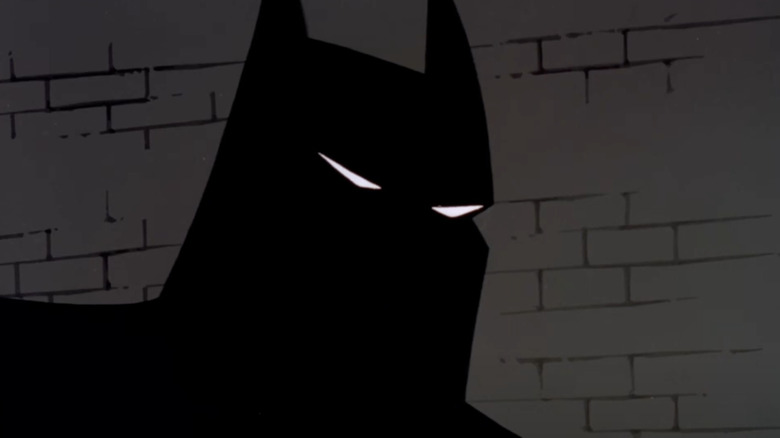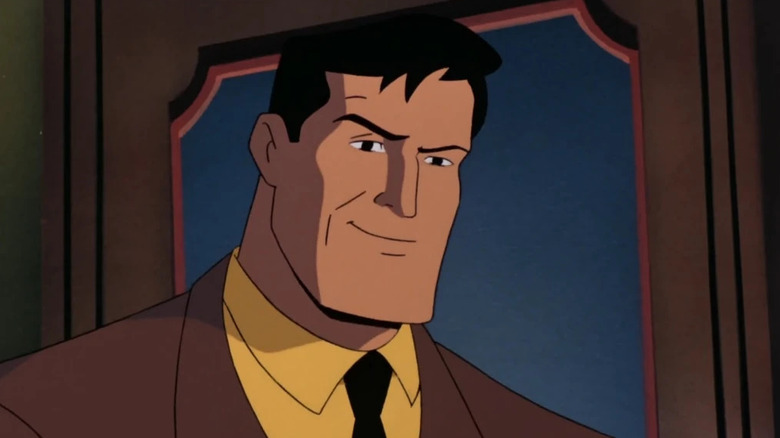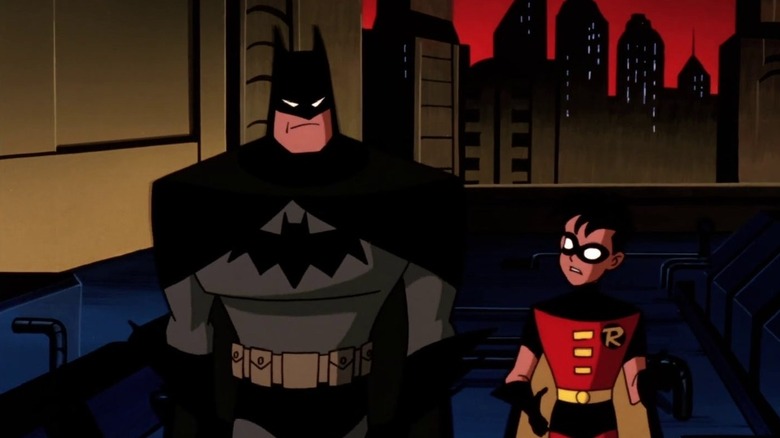Why Kevin Conroy Changed His Batman Voice For The New Batman Adventures
We may receive a commission on purchases made from links.
The late Kevin Conroy will always be the voice of Batman. His 30 year tenure in the role, from "Batman: The Animated Series" to Conroy's fitting bow-out in "Justice League: Crisis on Infinite Earths — Part Three," is immortal. Conroy brought his own life into the performance that redefined the Dark Knight; as a gay man living in mid-20th century America, Conroy could relate to Batman keeping secrets and pain bottled up inside.
But across his many times voicing Batman, Conroy's voice shifted. During the original run of "Batman: The Animated Series," Conroy's Batman voice wasn't quite as deep as it became. He also gave the character two voices: a light and laidback one for Bruce Wayne (which was Conroy's own natural voice) and a stern one for Batman.
Then, in 1997, the series relaunched with an updated art style as "The New Batman Adventures." That wasn't the only change: Conroy started using a single and even deeper voice to play both Bruce Wayne and Batman. The "New Batman Adventures" voice is also the one that Conroy used again in the follow-up "Justice League" cartoon and then in the "Batman: Arkham" video games.
Asked about the switch on Twitter in 2020, Conroy explained that ditching the two voices had been series co-creator Bruce Timm's call. "[Timm] wanted the darkness of the Batman voice to permeate the show. None of the lightness of Bruce Wayne of the early shows," Conroy recalled. This darker voice was part of the overall shift in creative direction between "Batman: The Animated Series" and "The New Batman Adventures."
Kevin Conroy originally used different voices for Batman and Bruce Wayne
Conroy's double voice act is the same trick Adam West used when playing Batman, drawing a line between the man in the mask and out of it. It also allows for a more flexible character; Batman isn't a frowny sourpuss all the time. Look at the feature film spin-off "Batman: Mask of the Phantasm." That movie includes flashbacks to when Bruce Wayne was first preparing to be Batman, and in those he speaks with Conroy's lighter voice. That allows for Bruce to share romantic dialogue with his girlfriend Andrea Beaumont (Dana Delany) and, in Conroy's greatest Batman moment, be vulnerable in front of his parents' grave. Those scenes wouldn't be quite as resonant if Conroy played them with Batman's stoic growl.
Two voices also suggest that Batman is disguising his voice so that even people who know Bruce Wayne won't recognize him. Conroy once explained it as a convention, adding that he pitched the idea of using two distinct voices for Bruce and Batman:
"[Bruce Wayne is] the wealthiest man in Gotham. He's the most eligible bachelor, everyone knows he's got the big house on the hill, he's Steve Jobs and Michael Bloomberg and whoever all rolled into one. How can this guy put on a cape and a cowl and no one knows it's him? That's just impossible. So, let's not suspend belief so much. Why don't you let me do two voices and let me use my own voice for Bruce Wayne and then I'll use the voice that I used in the audition for Batman?"
The series' pilot "On Leather Wings" has a moment when Batman is in the Batcave working on a case, then adjusts his voice to "Bruce Wayne mode" to answer a phone call. This choice comes with subtext: the Batman voice is Bruce's true one. He's not lowering his voice to be Batman (the way Christian Bale later would in the "Dark Knight" films), he's lightening it to be Bruce Wayne.
Again, that fits the established character. "Batman is the real man, Bruce Wayne is the mask" can be a reductive analysis, but the fact is that Bruce Wayne is a lot darker and more damaged than he lets slip in public. Batman being the "real voice" becomes text in "The New Batman Adventures," when the laidback Bruce Wayne voice disappears entirely. Whether he's in the Batsuit or a business suit, Bruce Wayne uses the firm voice of the Dark Knight.
But wait, how does that account for the young Bruce having the lighter voice during the "Mask of the Phantasm" flashbacks? Simple: he's been Batman so long and lost himself so deeply in his shadow self that Batman's voice overtook his own. Batman falling into his own darkness is another theme that "The New Batman Adventures" explored.
The New Batman Adventures made Batman darker to balance the series' tone
Bruce Timm famously redesigned the Gotham City ensemble for "The New Batman Adventures" — some changed little like Harley Quinn, others changed a lot like Scarecrow. Batman's own costume redesign shows the darker direction the creators wanted. Gone were the blue highlights on the black and the yellow oval around the Bat symbol on his chest. (Timm himself compared the redesign to David Mazzucchelli's Batman from "Batman: Year One.")
Now, was "The New Batman Adventures" darker overall than "Batman: The Animated Series"? Yes and no. On one hand, the censors at Kids' WB (where "The New Batman Adventures" aired) were apparently less strict than those at Fox Kids (where "Batman: The Animated Series" had run). Characters could die more explicitly: Take "Growing Pains," where Robin befriends a doomed orphan named Annie. In "The New Batman Adventures," the creators also finally got to introduce Firefly, whereas Fox Kids had vetoed the pyromaniac villain.
"At Fox, they were really picky, not just about things you couldn't do, but just in terms of content and story. They had a million opinions about what we should be doing. Nobody bothers us like that at the WB," as writer/producer Paul Dini explained in "Wizard" Magazine #72.
Yet, the new art style was less moody than the original. The creators focused more on big set-pieces than in the original series, hence slicker animation. "The New Batman Adventures" wasn't lighter than the first 85 episodes, but it could be broader, including how it appealed to kids.
In "Batman: The Animated Series," Batman only had the college-aged Dick Grayson (Loren Lester) as Robin. In "The New Batman Adventures," Dick had become Nightwing, Barbara Gordon (Tara Strong) was a full-time Batgirl, and 13-year-old Tim Drake (Mathew Valencia) stepped up as Robin. Tim would be a Robin who the young boys watching could see themselves in.
You might be thinking that a Bat-family would warm Bruce Wayne's heart... and you'd be wrong. Instead, Timm and co. decided that Batman should get darker to counterbalance the show around him getting lighter.
"[Batman is] not a scout leader. He has these sidekicks around and they're part of a team, but they're somewhat wary of him. They keep their distance because this guy could go off," Dini noted. The episode "Old Wounds" flashes back to show how Bruce and Dick fell out; the original Robin quit because Batman was getting darker and more secretive than ever.
"We're always looking for opportunities to cut down [Batman's] dialogue and add an intensity to what he's saying," added Dini. Part of that intensity was writing Batman as someone who has no time to put on his Bruce Wayne mask (voice and all) in the morning.


